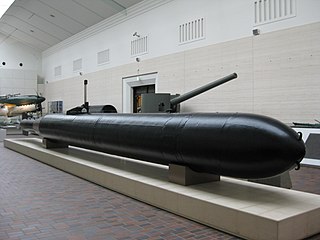Arizona has been the name of three ships of the United States Navy and will be the name of a future submarine.
USS North Carolina may refer to:
I-52, code-named Momi was a Type C-3 cargo submarine of the Imperial Japanese Navy used during World War II for a secret mission to Lorient, France, then occupied by Germany, during which she was sunk.

USS Snook (SS-279), a Gato-class submarine, was the first ship of the United States Navy to be named for the common snook, an Atlantic marine fish that is bluish-gray above and silvery below a black lateral line.

Kaiten were manned torpedoes and suicide craft, used by the Imperial Japanese Navy in the final stages of World War II.

I-400 was an Imperial Japanese Navy Sentoku-type submarine commissioned in 1944 for service in World War II. Capable of carrying three two-seat Aichi M6A1 "Seiran" float-equipped torpedo bombers, the Sentoku-class submarines were built to launch a surprise air strike against the Panama Canal. Until 1965, the Sentaku-type submarines—I-400 and her sister ships I-401 and I-402 —were the largest submarines ever commissioned.
Imperial Japanese Navy submarines originated with the purchase of five Holland type submarines from the United States in 1904. Japanese submarine forces progressively built up strength and expertise, becoming by the beginning of World War II one of the world's most varied and powerful submarine fleets.
The second I-55 was one of three Type C cruiser submarines of the C3 sub-class built for the Imperial Japanese Navy. Commissioned in April 1944, she was lost in July 1944 while taking part in the Marianas campaign during World War II.

I-19 was a Japanese Type B1 submarine which damaged and destroyed several enemy ships during World War II while serving in the Imperial Japanese Navy. During the Guadalcanal Campaign, with a single torpedo salvo, the submarine sank the aircraft carrier USS Wasp and the destroyer USS O'Brien and damaged the battleship USS North Carolina.

The HA. 19 is a historic Imperial Japanese Navy Type A Kō-hyōteki-class midget submarine that was part of the Japanese attack on Pearl Harbor on 7 December 1941. The submarine's crew was ordered to enter Pearl Harbor, attack the moored American warships with its two torpedoes and then scuttle her with explosives. However, the crew was unable to enter the harbor due to navigational difficulties, and the submarine ran aground and was captured by American forces.
U-55 may refer to one of the following German submarines:
Several ships have been named Matsu:
The Cruiser submarine Type-C was one of the first classes of submarine in the Imperial Japanese Navy (IJN) to serve during the Second World War. Type-C submarines were better armed than the Type-A and Type-B. The Type-Cs were also utilized as Kō-hyōteki or Kaiten mother ships, for this reason they were not equipped with aviation facilities.
Japanese submarine I-52 may refer to one of the following submarines of the Imperial Japanese Navy:
Japanese submarine I-24 may refer to one of the following submarines of the Imperial Japanese Navy:
Japanese submarine I-22 may refer to one of the following submarines of the Imperial Japanese Navy:
I-53 or Japanese submarine I-53 may refer to more than one submarine:
Japanese submarine I-58 may refer to one of the following submarines of the Imperial Japanese Navy:
The second I-53 was the second of three Type C cruiser submarines of the C3 sub-class built for the Imperial Japanese Navy. Commissioned in February 1944, she operated primarily as a kaiten manned suicide attack torpedo carrier during the final year of World War II and sank the destroyer escort USS Underhill (DE-682). Surrendered at the end of the war, she was scuttled by the United States Navy in 1946.
Ro-55 or Japanese submarine Ro-55 may refer to more than one submarine of the Imperial Japanese Navy:
This page is based on this
Wikipedia article Text is available under the
CC BY-SA 4.0 license; additional terms may apply.
Images, videos and audio are available under their respective licenses.




